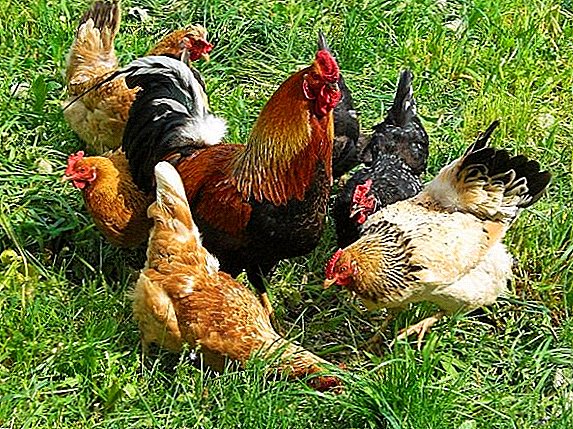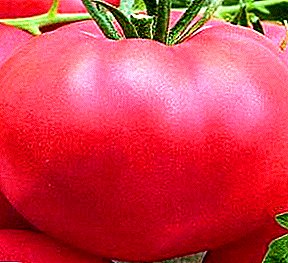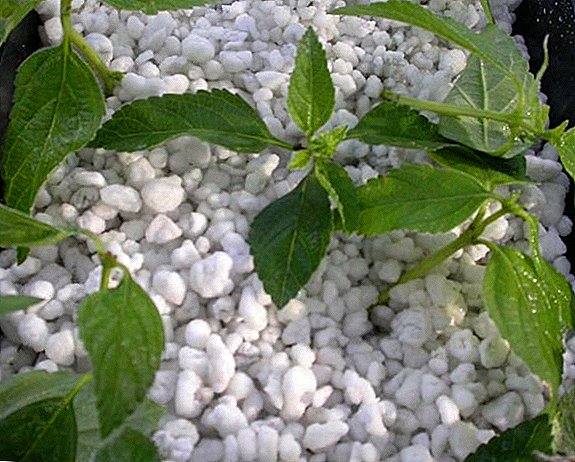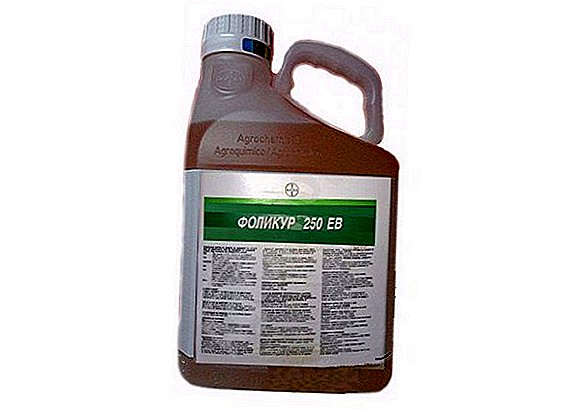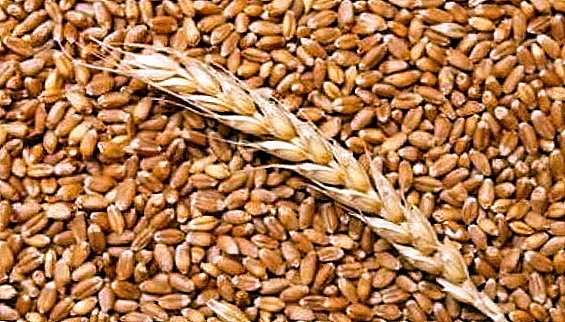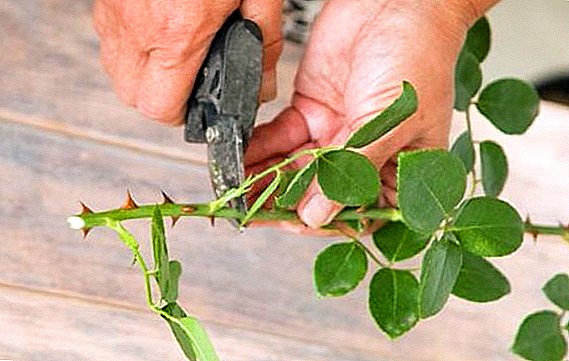 After the presented bouquet of roses crumbled, often there is a desire to plant cuttings and grow the queen of flowers on their own. We will tell how to produce cuttings of roses in the fall, whether it can be done at home, whether it is possible to root a rose from a bouquet and other secrets of growing roses at home.
After the presented bouquet of roses crumbled, often there is a desire to plant cuttings and grow the queen of flowers on their own. We will tell how to produce cuttings of roses in the fall, whether it can be done at home, whether it is possible to root a rose from a bouquet and other secrets of growing roses at home.
What roses will do
Not all varieties of roses are capable of breeding cuttings. This is very good at climbing roses. Many miniature varieties, polyanthaceae, hybrid polyanthanes, floribunda, and some tea varieties, for which neither stockings, nor budding are needed, also perform well with this method. This process is very bad with wrinkled park and yellow roses. 
Did you know? Getting cuttings from a bouquet with imported roses, most likely, will not work. Such flowers are processed with special preparations that prevent wilting and falling off of the petals. Prefer domestic roses.
Classic way: step by step process
Both for beginners and experienced flower growers, this method allows cutting the roses without frills, simply and clearly.
Stocking
The first thing you need is the cuttings themselves. Create them in the fall or summer. Autumn cuttings, lignified, prepared after full maturation of flowers. Choose even strong stems with a diameter of 4-5 mm.  Green or summer cuttings are prepared until the bush is woody completely. It happens around the time of the first flowering. For reproduction, choose smooth flowering shoots. We need the middle part of such a shoot. Such shoots take root best.
Green or summer cuttings are prepared until the bush is woody completely. It happens around the time of the first flowering. For reproduction, choose smooth flowering shoots. We need the middle part of such a shoot. Such shoots take root best.
Important! Very green or already lignified shoots take root much worse.The procurement process is the same for all options:
- make the lower cut right under the kidney, at an angle of 45 degrees;
- at a distance of 13-15 cm make the upper cut. It should be made 1 cm above the kidney at a right angle to the trunk;
- thorns are removed, leaves are removed from below, and the upper ones are cut to one third. Process the upper cut with a solution of potassium permanganate or brilliant green;
- put the cuttings in water or a solution of potassium humate;
- now the cuttings are ready for rooting.

Rooting
So, our cuttings are ready, kept in solution and can be rooted.
There are several ways to root the resulting seedlings.
- In water. The easiest and easiest way, it is through it that beginners will learn how to root a rose from a bouquet. In a clean container, pour cold boiled water. Approximately 2.5-4 cm. Put back roses. Periodically fill there with fresh settled water. You can add a root growth stimulator to the water. Put the container in a bright place, but so that the sun does not fall into it. After about three to four weeks, callus and new processes will appear, and now everything is ready for planting in a pot or open ground. When planting in the ground germinated plants should be closed with a can or a plastic bottle. With this method there is a risk of death of seedlings due to lack of oxygen. Yes, and it is suitable mainly for miniature roses.
- Rooting into the soil. In this case, freshly cut cuttings are planted immediately in pots with earth. The cuttings are left in the solution of the humate or the rotor for a day. During this time, prepare pots for planting. Their walls are treated with potassium permanganate solution, drainage is poured to the bottom (stones, pebbles). Then pour the soil (you can take the usual garden, you can use a special soil for roses), about two-thirds of the pot. The remaining volume is filled with washed sand. The cuttings are inserted only into the sand at an angle, without in any way touching the ground - otherwise the sapling will rot from the absence of oxygen. Now the pot is covered with a can or a plastic bottle and cleaned in a dark place. When planting in a greenhouse or boxes, the procedure is exactly the same, but you should maintain a distance between the seedlings of 10 cm.
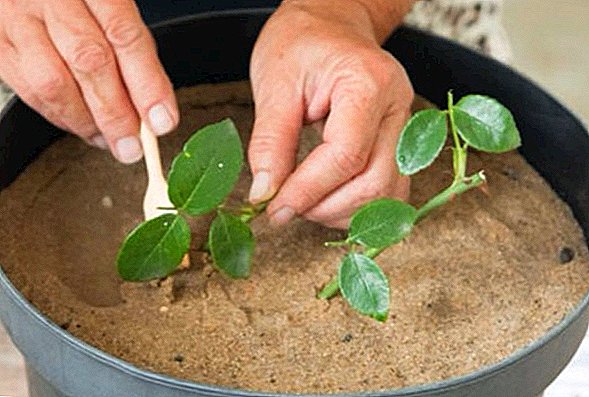 And cover them with an opaque film or non-woven material. A month later, the cuttings are already rooted, and they can be transplanted in open ground. Shortly before this, the plants begin to accustom themselves to fresh air, taking shelter for a while. Do not forget to water the land all the time and do not let it dry.
And cover them with an opaque film or non-woven material. A month later, the cuttings are already rooted, and they can be transplanted in open ground. Shortly before this, the plants begin to accustom themselves to fresh air, taking shelter for a while. Do not forget to water the land all the time and do not let it dry.

Important! It is possible to plant a seedling into the ground after a young shoot appears from the leaf bosom. This means that the roots have grown and started.
Landing
So, we have a young sprout, and our cuttings have become full saplings. Now they are ready for planting in a place of constant growth.
Growing roses from cuttings is carried out in the autumn or spring. During spring planting, the soil temperature should be above + 10 ... +13 ° С. In the fall, everything must be finished by mid-October (but not earlier than mid-September), so that before winter the seedlings can take root and prepare for frost. If you plant them too early, while it is warm, the plant will shoot shoots that will freeze and destroy the plant during frosts.
Did you know? In the works of Shakespeare, the rose is mentioned more than 50 times. In honor of the great playwright named one of the varieties of these flowers.The hole is dug a little more than the pot in which the seedling has grown, so that the plant is free. Down humus or compost is poured down and sprinkled with earth - the roots of seedlings should not touch fertilizer. Cuttings from pots are planted along with an earthy ball. If the roots are without land, then they should be soaked in the coil.
The sapling is set vertically in a hole, sprinkled with earth and tamped tightly. Then watered. If you plan to grow roses with cuttings, cover them with cans, cut off plastic bottles or special material, an additional advantage will be throwing all this with grass or needles to warm the soil in the fall and calmly enter the winter.  Spring seedlings are also hiding, watering is carried out around the shelter. After the leaves appear, the seedling begins to accustom to the open air - the shelter is removed first for half an hour, gradually increasing the time.
Spring seedlings are also hiding, watering is carried out around the shelter. After the leaves appear, the seedling begins to accustom to the open air - the shelter is removed first for half an hour, gradually increasing the time.
Important! Do not forget to daily moisten the soil around the seedling. But do not overdo it - an excess of moisture is harmful to roses.
Seedlings should be insulated within two winters after planting. And only then they are able to winter independently.
About other ways
In addition to these classic methods of rooting, there are several other options.
Learn more about the features of growing: climbing, tea, Dutch, standard, English, Canadian roses.
Potato
The methods listed above have their drawbacks. There is little oxygen in the water and the plant can rot, and in the ground it can dry out due to lack of moisture. Inventive growers have come up with a clever way to avoid these dangers. They became rooting in potatoes.  To do this, a large potato tuber is taken, cleared of all eyes (this is very important, otherwise the potato will start to grow soama and spend its energy not on roses). Half of the tuber sticks stuck and planted in the ground for 5-6 cm.
To do this, a large potato tuber is taken, cleared of all eyes (this is very important, otherwise the potato will start to grow soama and spend its energy not on roses). Half of the tuber sticks stuck and planted in the ground for 5-6 cm.
Important! With this method, it is not necessary to cover the rose.In this form, the stalk winters beautifully and grows until spring. And the tuber serves as an additional feeding. In spring, the seedling is ready for transplanting. But it is better to immediately plant in a place of constant growth.
Packages
The meaning of this method is to create high humidity and evaporation. To do this, the prepared segments are wrapped in wet moss or peat moistened with a rooting agent, placed in a plastic bag. The package is sealed and inflated, then placed in a sunny place.  Due to the high humidity in the package and artificial fog, the cuttings start to grow faster and after a couple of weeks the roots appear.
Due to the high humidity in the package and artificial fog, the cuttings start to grow faster and after a couple of weeks the roots appear.
Burrito
The name of this method is obliged to Mexican food. In the original, a burrito is a tortilla filled inside. In our case, the newspaper will serve as a cake, and the freshly cut sprigs of roses will serve as the filling.
The newspaper should be wet, but not wet. And in this, wet, kind of newspaper support all the time, until the roots appear.  It is also possible to wrap the bundle with an additional plastic wrap or place it in a bag.
It is also possible to wrap the bundle with an additional plastic wrap or place it in a bag.
This method is simple, but the probability of germination is extremely small.
Did you know? In Germany, in the cathedral in Hildesheim rose rose over 1000 years old. This is the oldest such flower.
Trannua
This method was proposed by renowned expert Pavel Tranua.
In this case, everything is done during flowering and active growth of flowers - in the summer. The stems of roses are cut, pinned and left until the buds begin to swell at the bottom. This will indicate that the material is mature and ready to go. It is worth paying attention to the fact that the buds do not develop into leaves, otherwise the result will not be. Planting cuttings in open ground as usual. Further care is also carried out according to the standard scheme - soil moistening, accurate loosening.  Each of the methods described has its pros and cons. Each is verified and allows you to get a result. You should choose the way that fits your abilities and knowledge. But even the simplest option will give you the answer to the question: how to grow a rose from a cutting from a presented bouquet.
Each of the methods described has its pros and cons. Each is verified and allows you to get a result. You should choose the way that fits your abilities and knowledge. But even the simplest option will give you the answer to the question: how to grow a rose from a cutting from a presented bouquet.


 And cover them with an opaque film or non-woven material. A month later, the cuttings are already rooted, and they can be transplanted in open ground. Shortly before this, the plants begin to accustom themselves to fresh air, taking shelter for a while. Do not forget to water the land all the time and do not let it dry.
And cover them with an opaque film or non-woven material. A month later, the cuttings are already rooted, and they can be transplanted in open ground. Shortly before this, the plants begin to accustom themselves to fresh air, taking shelter for a while. Do not forget to water the land all the time and do not let it dry.